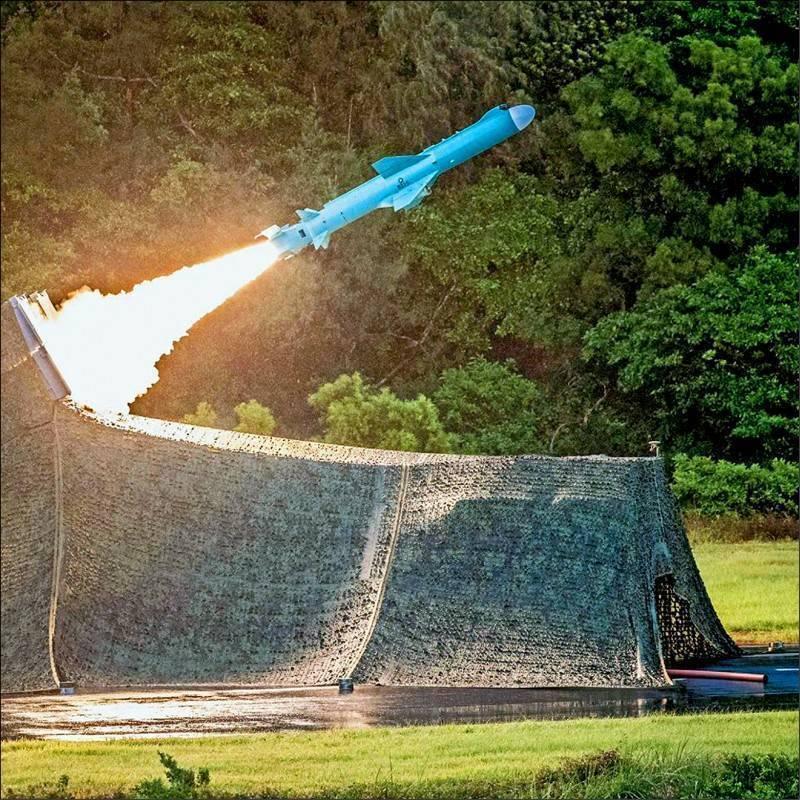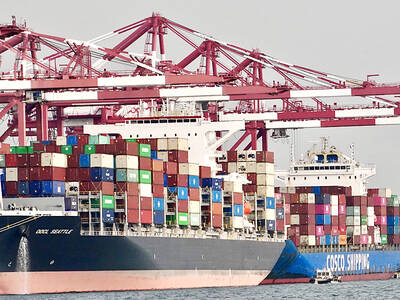China’s Soviet-build aircraft carrier Liaoning could be as easily sunk as the flagship of Russia’s Black Sea fleet, the Nikkei Shimbun reported yesterday.
The Russian guided-missile cruiser Moskva sank on Thursday last week after Ukraine said it struck the ship with locally made Neptune anti-ship missiles. Russia has denied the ship was hit, instead saying it sank after a fire broke out on the vessel.
The ease with which the Moskva was sunk has shocked Chinese defense officials, who fear the Liaoning could be similarly vulnerable in a military conflict, the Nikkei reported.

Photo: Screengrab from video of Ministry of National Defense
The Liaoning was originally the Kuznetsov-class carrier Varyag, which China bought from Ukraine in an unfinished state after it was stripped of equipment.
Beijing also purchased the hulls of two other Soviet-era carriers, the Kiev and the Minsk, for study and refitting.
All three ships were laid down in the Mykolaiv Shipyard in Ukraine, the paper said.
Armor standards used in Russian warships built during the Cold War suggest that the Liaoning might not fare any better than the Moskva against anti-ship missiles, the newspaper cited an expert as saying.
Should a conflict break out in the Taiwan Strait, the Chinese navy might avoid deploying the Liaoning, as the ship could be too vulnerable, the expert said.
While China’s newer Shandong and yet-unnamed third carrier likely have improved defenses, they would remain in missile range when sailing toward Taiwan or the Pacific, they said.
That Russia — widely considered to have overwhelming superiority in equipment, troop numbers and financial resources — would flounder in its invasion of Ukraine has disturbed the Chinese government, they said.
Taiwan is protected by the sea and could use its mountain ranges as natural fortifications, which makes the nation a harder target than Ukraine, the expert said, adding that China is more vulnerable than Russia to sanctions due to its reliance on energy and food imports.
Speaking on condition of anonymity, a Taiwanese defense official said that Taiwan is buying 100 ground-launched Harpoon anti-ship missiles in addition to variants that can be fired from ships, submarines and aircraft.
The number and type of missiles to be purchased are based on the projection that Taiwan needs to sink 70 percent of a hostile amphibious ship group to stop an invasion plan from being executed, they said.
Defense International magazine news editor Chen Kuo-ming (陳國銘) said that Taiwan is better armed than Ukraine in terms of anti-ship missiles.
China must use its capital ships to escort an amphibious vessel group in an invasion of Taiwan, he said, adding that Taiwan’s Hsiung Feng III missiles can hit targets anywhere in the Strait.
The Taiwanese military’s emphasis on mobility and variety of launch platforms for its anti-ship missiles are broadly correct, Chen said, adding that miniaturizing Hsiung Feng II missiles for use by fighter aircraft should be considered for increased tactical flexibility.
In related news, the Ministry of National Defense in a classified report to the Legislative Yuan yesterday revealed that Hsiung Sheng surface-to-surface cruise missiles can be mounted with high-explosive or cluster munition warheads.
That means the Hsiung Sheng — which has a range of 1,000km to 1,200km — could attack ground targets in China, including fortified command centers and airfields, by using the warheads, a source familiar with the report said.
The missiles would supply long-range precision strike capability for the military’s deterrence strategy, the source said.
The ministry has asked for a budget of NT$16.1 billion (US$550.45 million) for the missiles from this year to 2025.
Taiwan would have the capacity to produce 113 missiles per year after the Chungshan Institute of Science and Technology’s manufacturing facilities come online, it said.
The number of missiles the military would actually obtain has not been made public.

The Central Weather Administration (CWA) yesterday said it expected to issue a sea warning for Typhoon Fung-Wong tomorrow, which it said would possibly make landfall near central Taiwan. As of 2am yesterday, Fung-Wong was about 1,760km southeast of Oluanpi (鵝鑾鼻), Taiwan’s southernmost point, moving west-northwest at 26kph. It is forecast to reach Luzon in the northern Philippines by tomorrow, the CWA said. After entering the South China Sea, Typhoon Fung-Wong is likely to turn northward toward Taiwan, CWA forecaster Chang Chun-yao (張峻堯) said, adding that it would likely make landfall near central Taiwan. The CWA expects to issue a land

Taiwan’s exports soared to an all-time high of US$61.8 billion last month, surging 49.7 percent from a year earlier, as the global frenzy for artificial intelligence (AI) applications and new consumer electronics powered shipments of high-tech goods, the Ministry of Finance said yesterday. It was the first time exports had exceeded the US$60 billion mark, fueled by the global boom in AI development that has significantly boosted Taiwanese companies across the international supply chain, Department of Statistics Director-General Beatrice Tsai (蔡美娜) told a media briefing. “There is a consensus among major AI players that the upcycle is still in its early stage,”

The Central Weather Administration (CWA) yesterday said it is expected to issue a sea warning for Typhoon Fung-wong this afternoon and a land warning tomorrow. As of 1pm, the storm was about 1,070km southeast of Oluanpi (鵝鑾鼻), Taiwan’s southernmost point, and was moving west-northwest at 28 to 32kph, according to CWA data. The storm had a radius of 250km, with maximum sustained winds of 173kph and gusts reaching 209kph, the CWA added. The storm is forecast to pass near Luzon in the Philippines before entering the South China Sea and potentially turning northward toward Taiwan, the CWA said. CWA forecaster Chang Chun-yao (張峻堯) said

PREPARATION: Ferry lines and flights were canceled ahead of only the second storm to hit the nation in November, while many areas canceled classes and work Authorities yesterday evacuated more than 3,000 people ahead of approaching Tropical Storm Fung-wong, which is expected to make landfall between Kaohsiung and Pingtung County this evening. Fung-wong was yesterday morning downgraded from a typhoon to a tropical storm as it approached the nation’s southwest coast, the Central Weather Administration (CWA) said, as it issued a land alert for the storm. The alert applies to residents in Tainan, Kaohsiung, Pingtung and Taitung counties, and the Hengchun Peninsula (恆春). As of press time last night, Taichung, Tainan, Kaohsiung, and Yilan, Miaoli, Changhua, Yunlin, Pingtung and Penghu counties, as well as Chiayi city and county had